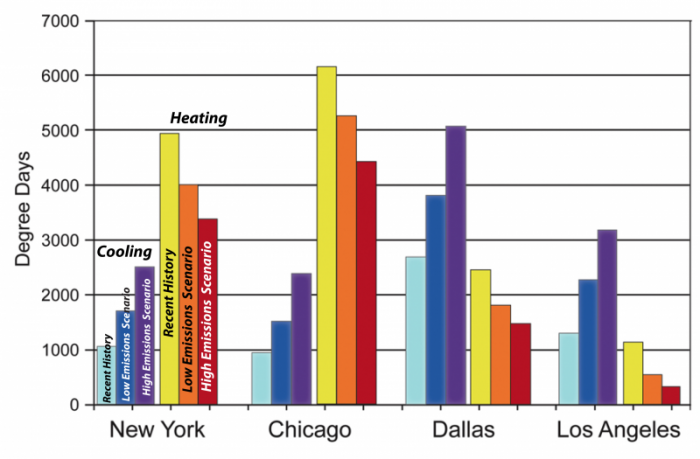Energy Resources
Energy production and use are the most important means by which we are altering the global climate and, in turn, the changing climate will impact our energy production and consumption in a variety of ways.
Warming will be accompanied by decreases in demand for heating energy and increases in demand for cooling energy. The latter will result in significant increases in electricity use (most cooling uses electricity; heating uses a wider array of energy sources) and higher peak demand in most regions. This picture obviously changes around the country and the globe, but there has been more growth in the US in regions that are mainly cooling regions, thus exacerbating this effect. The general picture is illustrated by looking at 4 major cities in this graph that shows the degree days for heating and cooling at the present and as expected in the future under different emissions scenarios.

One heating degree day is one day where the outside temperature is 1°F below 65°F; two cooling degree days is either one day at a temperature of 67°F or two days at 66°F. If you then sum these up for a whole year, you have the data shown in this figure (Recent History bars). The colder cities like Chicago and New York have larger heating degree day sums than cooling degree day sums.
Energy production is likely to be constrained by rising temperatures and limited water supplies in many regions. Power plants are the second biggest user of surface water (after irrigation) and the hotter it is, the more water is needed to cool the plants. At the same time, as the water warms, you need more of it to accomplish the same cooling job. A powerful example of this effect comes from the French heat wave of 2003, during which a number of nuclear power plants had to halt production because the cooling water was not cool enough to safely continue generating electricity.
Energy production and delivery systems are exposed to sea-level rise and extreme weather events in vulnerable regions. A good example of this comes from Port Fourchon, Louisiana, which supports 75% of deepwater oil and gas production in the Gulf of Mexico, and its role in supporting oil production in the region is increasing. The Louisiana Offshore Oil Port, located about 20 miles offshore, receives 1.3 million barrels of oil per day and transfers it to refineries, accounting for 50% of our nation's refining capacity, making this one of the most important components of our energy production system. One road, Louisiana Highway 1, connects Port Fourchon with the nation, and it is increasingly vulnerable to flooding during storms due to the combined effects of sea level rise and ground subsidence. Louisiana is currently upgrading Highway 1, elevating it above the 500-year flood level in order to prolong its viability.
Climate change is also likely to affect some hydropower production in regions subject to changing patterns of precipitation or snowmelt.
How can we adapt to these coming changes? Part of the solution is to identify vulnerable features of our energy production system (such as Port Fourchon) and then safeguard them from the expected consequences of continued warming. Another big part of the adaptive strategy is to reduce our consumption of energy by increasing efficiencies in transportation (which we are already doing), home appliances, and buildings. New York City and Chicago have both undertaken massive programs to minimize the heat absorbed by their cities by planting trees and installing reflective or green roofs on buildings. Trees and green roofs cool by evapotranspiration, and the effect can be significant. These steps will reduce the cooling demands in these cities. We can also reduce the demand on power plants by more distributed, small-scale energy production that is carbon neutral. This is happening in a big way in many parts of Europe, where fields of solar panels have been springing up in farmers' fields — they are growing energy, attracted by strong support from the state-run utilities responsible for electricity.
